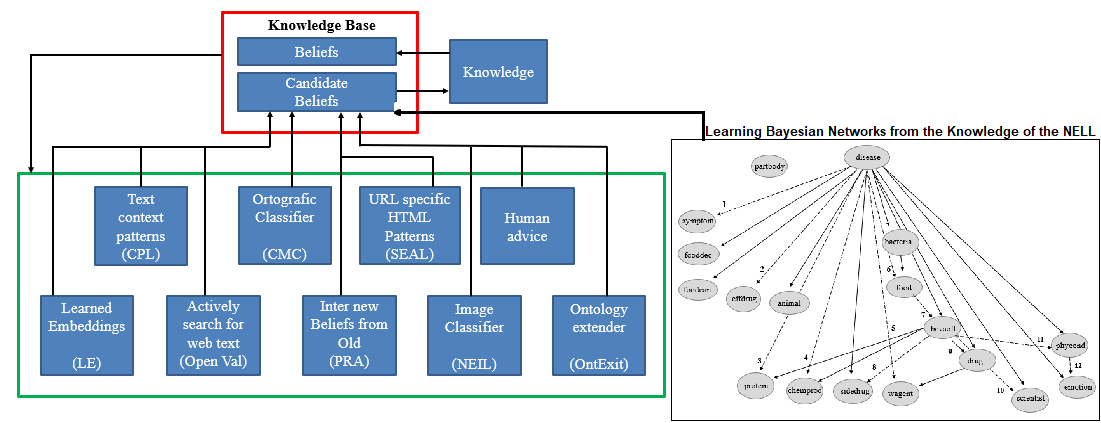Learning Bayesian Networks from the Knowledge of a Never-Ending Learning System
Keywords:
Bayesian networks, never-ending learning, machine learningAbstract
Never-Ending Learning (NEL) is a new paradigm of machine learning in which computer systems can learn continuously and incrementally. The first never-ending learning system reported in literature is named NELL (Never-Ending Language Learning). NELL has built a Knowledge Base (KB) containing many types of knowledge. In this paper, we propose to learn Bayesian networks from the knowledge stored in the NELL’s KB aiming to assist in the development of expert systems in the future. In addition, Bayesian networks have shown to be promising to solve the problem of representing semantic relations and extending the NELL’s initial ontology. In the initial experiments, we have built a dataset on the domain of diseases from relations existing in NELL and applied two learning algorithms of Bayesian networks named K2 and DMBC. The empirical results have shown that this proposal is promising.
Downloads
References
T. M. Mitchell, W. Cohen, E. Hruschka, P. Talukdar, B. Yang, J. Betteridge, A. Carlson, B. Dalvi, M. Gardner, B. Kisiel, J. Krishnamurthy, N. Lao, K. Mazaitis, T. Mohammad, N. Nakashole, E. A. Platanios, A. Ritter, M. Samadi, B. Settles, R. Wang, D. Wijaya, A. Gupta, X. Chen, A. Saparov, M. Greaves, and J. Welling, “Never-ending learning,” Commun. ACM, vol. 61, p. 103–115, Apr. 2018.
A. Carlson, J. Betteridge, B. Kisiel, B. Settles, E. H. Jr., and T. Mitchell, “Toward an architecture for never-ending language learning,” in Proceedings of the Conference on Artificial Intelligence (AAAI), pp. 1306–1313, AAAI Press, 2010.
A. F. Mansano et al., Aprendizado de máquina multivisão aplicado à análise de correferência em um sistema de aprendizado sem fim. Dissertation, Universidade Federal de São Carlos: UFSCar, 2018.
A. P. Appel and E. R. Hruschka Junior, “Prophet – a link-predictor to learn new rules on nell,” in 2011 IEEE 11th International Conference on Data Mining Workshops, pp. 917–924, 2011.
P. H. Barchi, Expansão de ontologia através de leitura de máquina continua. dissertation, Universidade Federal de São Carlos: UFSCar, 2014.
T. Mohamed, E. Hruschka, and T. Mitchell, “Discovering relations between noun categories,” in Proceedings of the 2011 Conference on Empirical Methods in Natural Language Processing, pp. 1447–1455, 2011.
S. Thrun and T. M. Mitchell, “Lifelong robot learning,” in The Biology and Technology of Intelligent Autonomous Agents (L. Steels, ed.), (Berlin, Heidelberg), pp. 165–196, Springer Berlin Heidelberg, 1995.
S. Thrun and L. Pratt, eds., Learning to Learn. USA: Kluwer Academic Publishers, 1998.
R. G. L. Miani, S. D. d. S. Pedro, and E. R. Hruschla, “Association rules to help populating a never-ending growing knowledge base,” in Ibero-American Conference on Artificial Intelligence, pp. 169–181, Springer, 2014.
R. G. L. Miani and E. H. Junior, “Exploring association rules in a large growing knowledge base”, International Journal of Computer Information Systems and Industrial Management Applications, vol. 7, pp. 106–114, 2015.
S. Verma and E. R. H. Jr., “Coupled bayesian sets algorithm for semisupervised learning and information extraction,” in Machine Learning and Knowledge Discovery in Databases - European Conference, ECML PKDD 2012, Bristol, UK, September 24-28, 2012. Proceedings, Part II (P. A. Flach, T. D. Bie, and N. Cristianini, eds.), vol. 7524 of Lecture Notes in Computer Science, pp. 307–322, Springer, 2012.
M. C. Duarte, Leitura da web em português em ambiente de aprendizado sem-fim. Dissertation, Universidade Federal de São Carlos: UFSCar, 2016.
D. T. Wijaya and T. Mitchell, “Mapping verbs in different languages to knowledge base relations using web text as interlingua,” in Proceedings of the 2016 Conference of the North American Chapter of the Association for Computational Linguistics: Human Language Technologies, pp. 818–827, 2016.
E. B. dos Santos, M. L. Fernandes, E. R. H. Jr., and M. C. Duarte, “Bayesian networks for identifying semantic relations in a never-ending learning system,” in Intelligent Systems Design and Applications - 16th International Conference on Intelligent Systems Design and Applications (ISDA 2016) held in Porto, Portugal, December 16-18, 2016 (A. M. Madureira, A. Abraham, D. Gamboa, and P. Novais, eds.), vol. 557 of Advances in Intelligent Systems and Computing, pp. 279–288, Springer, 2016.
E. B. dos Santos, I. H. P. Rodrigues, E. R. H. Jr., and L. R. Bruno, “Bayesian networks for inference and discovery of semantic relations in a never-ending learning system,” in 8th Brazilian Conference on Intelligent Systems, BRACIS 2019, Salvador, Brazil, October 15-18, 2019, pp. 687–692, IEEE, 2019.
J. Pearl, “Probabilistic reasoning in intelligent systems: networks of plausible inference—judea pearl,” 1988.
G. F. Cooper and E. Herskovits, “A bayesian method for the induction of probabilistic networks from data,” Mach. Learn., vol. 9, pp. 309–347, 1992.
E. B. dos Santos, E. R. H. Jr., E. R. Hruschka, and N. F. F. Ebecken, “Bayesian network classifiers: Beyond classification accuracy,” Intell. Data Anal., vol. 15, no. 3, pp. 279–298, 2011.
J. Pearl, Probabilistic reasoning in intelligent systems - networks of plausible inference. Morgan Kaufmann series in representation and reasoning, Morgan Kaufmann, 1989.
W. H. Hsu, “Genetic wrappers for feature selection in decision tree induction and variable ordering in bayesian network structure learning,” Information Sciences, vol. 163, no. 1, pp. 103–122, 2004. Soft Computing Data Mining.
R. E. Neapolitan, Learning Bayesian Networks. Prentice Hall, 2003.
I. H. Witten, E. Frank, and M. A. Hall, Data Mining: Practical Machine Learning Tools and Techniques. Morgan Kaufmann Series in Data Management Systems, Amsterdam: Morgan Kaufmann, 3 ed., 2011.
D. Poole, “First-order probabilistic inference,” in Proceedings of the 18th International Joint Conference on Artificial Intelligence, IJCAI’03, (San Francisco, CA, USA), p. 985–991, Morgan Kaufmann Publishers Inc., 2003.
A. Kimmig, L. Mihalkova, and L. Getoor, “Lifted graphical models: a survey,” Machine Learning, pp. 1–45, 2014.
O. Schulte, Z. Qian, A. E. Kirkpatrick, X. Yin, and Y. Sun, “Fast learning of relational dependency networks,” Mach. Learn., vol. 103, p. 377–406, jun 2016.


